 Taking on the task of writing about the late Dr. Badi-ud-din Mahmud is a challenge to anyone – moreso to the writer who cannot boast of any journalistic skill or prior experience. A revolutionary in a positive sense, he was a man with a mission from his early childhood. The very same flame that ignited him into public life remained intact and undiminished till his very end. He sought and loved challenges. Although some might describe him as arrogant, this was more the authoritarian countenance which he was gifted with from birth. He did not tolerate mediocrity; a perfectionist in every sense – to fail was never an option. However, that did not deter him from caring for the weak or less fortunate. He stood for what he thought was right and stood firm. This was a man with the skill to mix his varying qualities to great advantage, more for his country than himself. Above all, he was a true nationalist who loved his country and its people. His ideals were based upon progressive socialism which did not conflict with his faith.
Taking on the task of writing about the late Dr. Badi-ud-din Mahmud is a challenge to anyone – moreso to the writer who cannot boast of any journalistic skill or prior experience. A revolutionary in a positive sense, he was a man with a mission from his early childhood. The very same flame that ignited him into public life remained intact and undiminished till his very end. He sought and loved challenges. Although some might describe him as arrogant, this was more the authoritarian countenance which he was gifted with from birth. He did not tolerate mediocrity; a perfectionist in every sense – to fail was never an option. However, that did not deter him from caring for the weak or less fortunate. He stood for what he thought was right and stood firm. This was a man with the skill to mix his varying qualities to great advantage, more for his country than himself. Above all, he was a true nationalist who loved his country and its people. His ideals were based upon progressive socialism which did not conflict with his faith.
This unique man, who parted company on June 16, 1997, left behind an indelible mark in the history of this nation.
Dr. Mahmud’s (Buddy to his friends) life began on June 23, 1904 in the southern tip of Sri Lanka – the youngest child of a then average sized family of twelve. His lineage descends from the prominent ‘Mukaddam’ family of Weligama with a recorded ancestral history of more than twelve generations. His early childhood was shared between Weligama and Matara to where the Mukaddam family roots had spread. His father, popularly known as ‘Matara Mahataya’ was a respected figure in the local community, a title less due his wealth and more due to his popularity as a humanitarian amongst all the communities, who also established the now famous ‘Arafath Vidyalaya’ in Weligama. These traits Dr. Mahmud certainly inherited from his father; yet, it was his grandfather Seyed Mustapha Notaris (Weligama Korale Notaris Ralahamy), who lived to be a 100 and was well versed in the Sinhala and Tamil languages that was to be his early mentor and idol. They shared a close bond. Dr. Mahmud often spoke very affectionately of his grandfather who adored him. Upon the demise of his parents, one of his older brothers, Proctor Salahuddin took over responsibility and care of Dr. Mahmud with a family that was closely held together by mutual love and affection. In his adult years, as life blessed him with opportunities and success, Dr. Mahmud never did forsake his family or friends and was always available to attend to their concerns. At home he was a simple man who enjoyed the simple things in life.
Young Mahmud’s early education was at St. Thomas’ College Matara and Wesley College Colombo. Zahira College Colombo provided him the platform to engage in higher studies where he passed the Cambridge Senior exams. It was here that he first met the late S.W.R.D. Bandaranaike, who upon having returned from Oxford in 1925 was invited to speak at the Zahira College Colombo Literary Association where Dr. Mahmud was the Secretary. Thus began the very long and close friendship which would soon shape the future of Sri Lanka.
Dr. Mahmud, the all-rounder that he was, spread his time between academic studies and literary activities as well as athletics, cricket, boxing, tennis and cadetting (he attended the Diyatalawa camp as a corporal).
A rebel with a cause, at the age of fourteen while at St. Thomas’ College Matara, he refused to bow down to the Union Jack – an act for which he was rewarded with ‘six of the best’ courtesy of the principal’s rod. Again, while at Wesley College during the visit of the Prince of Wales, young Badi-ud-din absented himself from school that day as a show of protest against colonialism. When he was a young man, he was prevented from entering Burma (then known as Rangoon) by the British Raj due to his anti-imperialist stands. All this being just a glimpse of his revolutionary nature.
Having arrived in India, it was not long before Dr. Mahmud began to pursue his passion for becoming a leader and the voice of the students. He had the honour of sharing the platform with Indian freedom movement leaders of such stature as Jawaharlal Nehru and Mohamed Ali Jinnah who were appreciative of young Mahmud’s oratory skills.
In 1931, Aligarh University provided him the platform to launch his charge. Those who knew of his debating skills and his deeply resonating voice would not be surprised to learn that he was the first prize winner of the ‘All India Oratorical Contest’. His popularity and versatility were duly recognised when he was elected President of the All India Students Union. He utilised every opportunity he came across to travel the region, visiting among others, Afghanistan and Malaya (as it was then called); a vocal ant-imperialist, much to the dismay of the British.
Despite his success and the temptation to remain longer in India, he felt the irresistible need to answer the call of his motherland, to aid in the struggle for independence. And so he arrived back in Ceylon, armed with a Masters degree from the Aligarh University and began to launch his political career in the style and splendour that was his trade-mark.
He took to politics like a fish takes to water. He wasted no time in organising a mass meeting of Muslims on March 5, 1939 that was to mark the beginning of his political struggle for independence. He became the President of the Muslim League. This led him to rub shoulders with the giants of the independence movement while holding his own. His association with S.W.R.D. was renewed. Initially, he joined the UNP, as S.W.R.D. had done. However, their stay within the UNP camp was short lived due to disagreements with the leadership. At the time, rumour had it that S.W.R.D. (who was considered the most qualified to be the country’s first Prime Minister) submitted to the plea’s of the late D.S. Senanayake, who asked that S.W.R.D. not run against him for prime-minister ship on the promise that S.W.R.D. would succeed DS as the second Prime Minister of Sri Lanka. However, S.W.R.D. felt betrayed when the Lake House (whose owners were close kith and kin of DS) began publishing negative stories about S.W.R.D. and it was not long before he figured it all out. The rest is history. S.W.R.D. formed the SLFP with Dr. Mahmud as a founding member. Interestingly, it was the recommendation of Dr. Mahmud and Mr. Sri Nissanka KC that the official party colour be blue as it stood for prosperity. The subsequent 1956 elections were hard fought. The SLFP won by an unprecedented majority and reduced the UNP to just eight seats in Parliament. Dr. Mahmud’s contribution and support was invaluable to S.W.R.D. this earned him the position of the first joint General Secretaries of the SLFP along with Sri Nissanka in 1960.
Dr. Mahmud was later responsible for the formation of the Islamic Socialist Front, based on the belief that the SLFP had much more to offer to the Muslims of Sri Lanka against the illusionary promises of the UNP. True to his vision, he was responsible for transforming and uplifting the muslim community by creating a mass of educational and employment opportunities. Today, almost all Muslim intellectuals, academics and professionals are second and third generation descendants of the people whose lives were thus uplifted by Dr. Mahmud’s visionary work.
An educationist by heart, he took up the challenge of taking over the position of principal at Gampola Zahira College in 1944. For a southerner, Gampola was alien territory. The Tamil dialect used by the southerner was quite different to the ‘Gampola Tamil’ dialect. This gave rise to some light hearted wit and humor in the town of Gampola at his expense. When Dr. Mahmud took over, he found himself with seventy students and some Kadjan hut classrooms. It is due his sole and selfless efforts that Gampola Zahira College has been transformed to what it is today. Generations of students from all communities who have passed through the corridors of this great institution of learning will be ever so grateful to Dr. Mahmud.
The late S.W.R.D. could not have chosen a more qualified personality than Dr. Mahmud, to fill the role of the country’s United Nations representative. Dr. A.C.S. Hameed recalls in his condolence speech that when he visited the UN as Foreign Minister, people remembered Dr. Mahmud affectionately. His proficiency did not go unnoticed and he was elected Vice Chairman of the Social, Humanitarian and Cultural Committee at the UN General Assembly.
He was much shaken at the sudden and tragic death of S.W.R.D. Having returned to Sri Lanka, he faithfully and promptly supported Madam Srimavo Bandaranaike as she became the Prime Ministerial candidate at the general elections and won with a clear majority. Dr. Mahmud was awarded the portfolio of Minister of Education. This, his first tenure in office happened at a very controversial time, where he introduced a bill in Parliament to take-over control of the assisted schools. Much uproar, debate and discussion on this issue followed. In fact, a case filed by Zahira College Colombo went up to the Privy Council (the highest court of law) contesting its take-over. This was ironic, Gampola Zahira College being his alma-mater. Sadly, Dr. Mahmud’s plan to develop Zahira College as the premier school for Muslims along-side schools such as Royal College and Ananda College were shattered. The tragic condition and less than average standards of this school ever since, are an indictment of the Muslim leaders who then had neither the vision, nor the interest of the Muslim Community at heart when they resorted to subvert this take-over for political or other selfish reasons. Due to this, generations of young deserving children have been deprived of quality education and a brighter future.
Not willing to give up, he exerted his resources to the development of Gampola Zahira College. It also seemed that he had a specific strategy to overcome the complacency of the Muslim community, who did not seem to be thinking beyond their private business affairs. He was to stir the conscience and the minds of the community to look at education as a future option for progressive development. Being a nationalist he, along with Sir Razick Fareed encouraged Muslims to learn the Sinhala language. This proved to be invaluable to the Muslims both in terms of developing a common language in the country as well as for purpose of employment and business. He did not forget the people of the north and east where he set up the Jaffna University and several higher education colleges. The Pirivena Education Bill was introduced by him. The Sinhala language was given its due place in schools. He had no ulterior motives. His mission was simple – to serve the nation and people with equity irrespective of race or religion.
It seemed that Dr. Mahmud was never able to steer away from controversy. In fact, he seemed to thrive on it. As Minister of Health, he introduced the Medical Privatisation Bill; which would regulate private practice by government doctors. This too caused much debate and he was confronted with opposition from the medical profession. Undeterred, he stood firm and overcame these problems.
In hindsight, it seemed that Dr. Mahmud was the right person at the right time. His courage, determination and wit enabled him to overcome the challenges brought on by the magnitude of changes his government introduced in order to bring social justice to the people. He revamped the educational system, modernising it from colonial methods. Much of Sri Lanka’s contemporary education has its roots in the systems that he founded. He strongly believed in the education of girls and was often heard saying ‘educating a boy is educating an individual but educating a girl is educating a community’. The First Republican Constitution has embraced valuable contributions by Dr. Mahmud. Sri Lanka honoured him with the title of Deshamanya for his services to the country during the Presidency of the late J.R. Jayewardene.
Finding a fitting way to conclude this account of Dr. Mahmud will be akin to unraveling a riddle: there are so many aspects to his life. We have only managed to touch briefly on some parts of his life. The rabbit’s hole goes much deeper.
It is appropriate that we appreciate some of the things he enjoyed in his personal life. His taste for sartorial excellence, as his contemporaries knew was unmatchable. It was no wonder that he was referred to as the ‘best dressed politician’ in Parliament. He took great care about his appearance. Many who had the pleasure of dining at his house would know what kind of treats awaited them. From the tantalising aromas emanating from his talented wife’s kitchen to the delectable conversations that always accompanied the feast. Dr. Mahmud’s home was famous for being host to many interesting discussions and debates.
One could always tell from the activities in the kitchen that a feast was underway for a VIP. The range of culinary dishes -each one a unique work of art, was a delight to those fortunate to partake. His wife was an indispensable companion and an asset to him. Dr. Mahmud loved his food – from the sophisticated to his simple Matara favourites. Whenever he longed for a truly Matara meal, he would task one of his nieces the job of making a variety of his favourite dishes. As children, we found him to be a friendly uncle. Those days were nostalgic times when he used to load up his old Ford car with all his grand nieces and nephews and drive us up to the Dondra Light House or some other place of amusement. He seemed to enjoy those drives as much as we did.
Personally to me, my great uncle, whom I fondly called ‘Baddi Mama’, was also a godfather figure who oversaw my life and education. I have much to thank him for. I spent ten years of my boyhood under his stern watch at Gampola Zahira College. His strict code of fairness ensured that no one was spared the rod –not even his own grand-nephew. I recall one instance when I was a boy, as a prank, I decided to uproot and run away with the netball post while the girls match was in progress. Uncle Baddi had eyes and ears everywhere. The most faithful of these was the school peon, Krishnan. It was not long before I was summoned to his office and received six of his best, right across my palms. Needless to say that was the last time I made any attempt to play any more pranks – none that he knew of, anyway.
Today, twelve years has passed since Dr. Mahmud departed our world. The vacuum left by great leaders like Dr. Mahmud is felt even more keenly when contrasted against the calibre of Muslim leadership that we are left with in the present political arena. One ponders, nay, hopes that another Dr. Mahmud might appear and lead from where this great man left off.
May the Almighty Allah have mercy on his soul!
Post Disclaimer | Support Us
Support Us
The sailanmuslim.com web site entirely supported by individual donors and well wishers. If you regularly visit this site and wish to show your appreciation, or if you wish to see further development of sailanmuslim.com, please donate us
IMPORTANT : All content hosted on sailanmuslim.com is solely for non-commercial purposes and with the permission of original copyright holders. Any other use of the hosted content, such as for financial gain, requires express approval from the copyright owners.
 Sri lanka Muslims Web Portal Sri Lanka Muslims News Center
Sri lanka Muslims Web Portal Sri Lanka Muslims News Center



